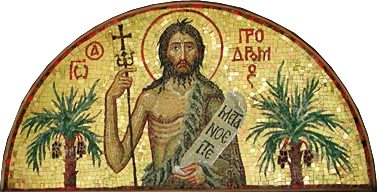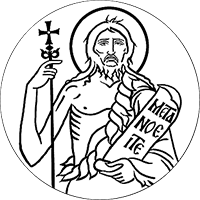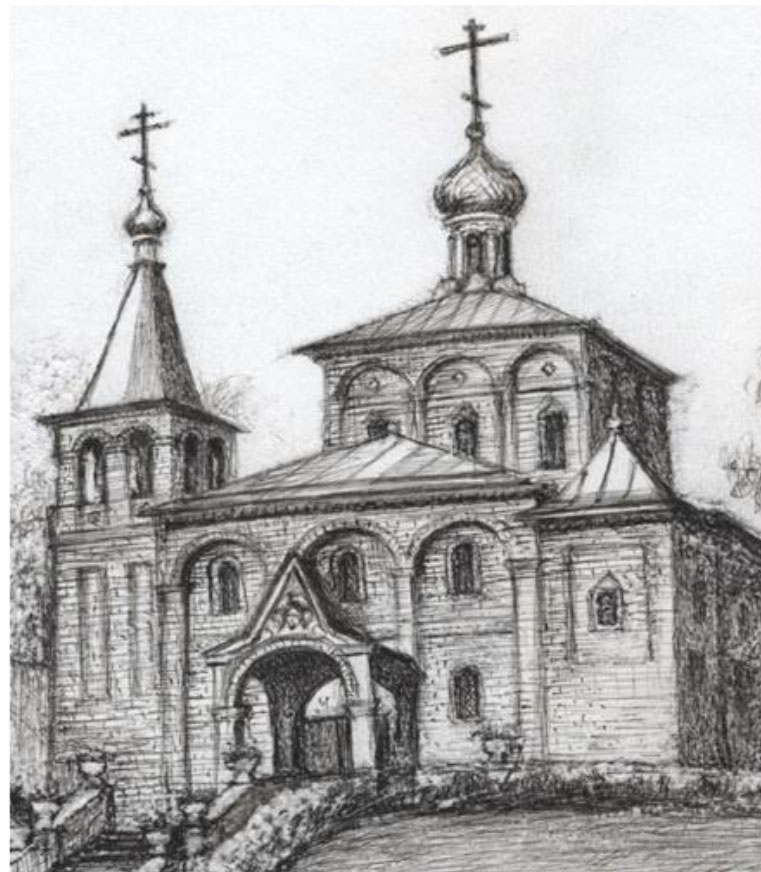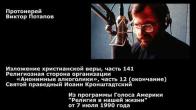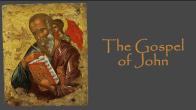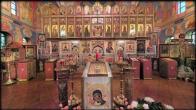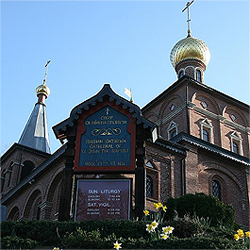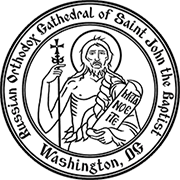You are here
Holy Theophany
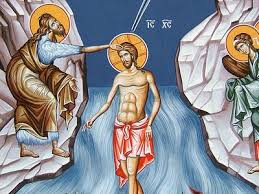
The Baptism of our Lord Jesus Christ is one of the twelve great feasts, one which is celebrated with no less solemnity than is the Nativity of Christ. One might say that the Nativity and the Baptism are two related holidays comprising one single celebration, the Feast of Theophany, for together they present to us the appearance of all three Persons of the Holy Trinity. In the cave in Bethlehem, the Son of God was born according to the flesh, and at His Baptism, from the Heavens the Holy Ghost descended in a bodily shape like a dove upon Him (Luke 3:22) and the voice of God the Father was heard, saying, Thou art My beloved Son; in Thee I am well pleased! (Luke 3: 22)
Holy Hierarch St. John Chrysostom writes that “it is not the day of the Savior’s birth that we should call His Appearance, but the day on which He was baptized. He did not become known to all by His Birth, but by His Baptism, and that is why it is not the day of His Birth that is called Theophany, but the day on which He was baptized.”
We can say the following about the actual Baptism of the Lord: Our Lord Jesus Christ, who had returned from Egypt after the death of King Herod, grew up in Nazareth, a small town in Galilee. With His Most-holy Mother, he remained in that small town until he was thirty, earning a living for himself and the Most-holy Virgin by following the craft of his supposed father, the Righteous Joseph, who was a carpenter. Upon attaining thirty years of earthly life (i.e. the age before which according to Jewish law one was not permitted to teach in the synagogues or accept the rank of priest), it was time for Him to appear to the people of Israel. However, before that moment, according to the prophets, there first had to appear to Israel the Forerunner, the one who bore responsibility for preparing the people of Israel to receive the Messiah, the one of whom the Prophet Isaiah prophesied: the voice of him that crieth in the wilderness, Prepare ye the way of the Lord, make straight in the desert a highway for our God (Isaiah 40: 3). Far from the people, in the depths of the severe Judaean Desert, the word of God came unto John, the son of Zacharias (Luke 3: 2), unto a kinsman of the Most-holy Virgin, who while still in the womb of his mother, the Righteous Elizabeth, leaped for joy to welcome his Savior, the One about Whom no one on earth except His Most-pure Mother, who had received the Good News from the Archangel, yet knew. That word of God directed John to go out into the world to preach repentance and to baptize Israel, to bear witness of the Light, that all men through him might believe. (John 1: 7).
Heeding God’s word, John walked throughout the land of Jordan, preaching the baptism of repentance for the remission of sins (Luke 3: 3). The whole Jewish land and the residents of Jerusalem went out to hear his preaching, to be baptized by him in the waters of the River Jordan, and to confess their sins (Mark 1: 5). Among the Jews who came to John there naturally arose the question: Was he Israel’s hoped-for Redeemer and Comforter? The Baptist replied: There cometh One mightier than I after me, the latches of Whose shoes I am not worthy to stoop down and unloose. I indeed have baptized you with water: but He shall baptize you with the Holy Ghost... (Mark 1: 7-8). And lo, on one of those ordinary days, as John was preaching to the Jews gathered at the Jordan, he was inspired by the Holy Spirit, and recognized among the people the One before Whom thirty years earlier he had leaped in his mother’s womb. Jesus had come from Galilee to Jordan to be baptized, along with everyone else, by John. John forbade Him, saying: I have need to be baptized of Thee, and comest Thou to me? (Matthew 3: 14). Seeing the Son of God, Who was not subject to sin, before him, John asked that he himself, who was under the sin of disobedience, which had passed from Adam to all of mankind, be baptized by Jesus Christ. And Jesus answering said unto him: Suffer it to be so now, for thus it becometh us to fulfill all righteousness… (Matthew 3: 15). Sinless and incorrupt, born of the Most-pure Virgin Mary, and in His Divinity the source of all purity and holiness, He had no need of that Baptism. However, as He had taken on Himself the sins of the entire world, he had come to the waters of the Jordan to purge them through Baptism. He came to be baptized, so as to sanctify the waters with Himself, so as to grant us the font of Holy Baptism. He also came to be baptized so that John might see the fulfillment of God’s word directing him to come out of the desert: Upon Whom thou shall see the Spirit descending, and remaining on Him, the same is He which baptizeth with the Holy Ghost. (John 1: 33).
St. John the Baptist obeyed Christ’s words, and the Jordan received into its waters the One by Whose command it had began to flow. According to the Gospels, after being baptized the Lord immediately came out of the water. Regarding that “immediately” Church tradition states that St. John the Baptist would hold anyone coming to be baptized neck-deep in the water until he had confessed all of his sins. Only after doing so would the person be allowed to come out of the water. Christ, Who was without sin, could not be held in the water, and therefore immediately came out of the river. As He was coming out of the water, the Heaven was opened, and the Holy Ghost descended in a bodily shape like a dove upon Him, and a voice came from Heaven, which said, Thou art My beloved Son; in Thee I am well pleased! (Luke 3: 21-22). Just as, in the days of Noah, the dove announced that the flood waters had receded, so here the dove pointed to an end to the flood of sin. The Holy Spirit appeared to the people in the form of a dove because that bird was the symbol of love, purity, and meekness. Thus the Holy Spirit is the source of purity, the bottomless depth of love for man, the teacher of humility and peace.
According to Church tradition, St. John the Forerunner’s preaching and his Baptism of the Savior took place at the site of the ancient crossing over Jordan, approximately 5 km from the river’s entrance into the Dead Sea. Already in the times of King David, a ferry had been set up there, and in the 19th Century the place was referred to as “Pilgrims’ Ford,” on account of the multitude of pilgrims coming together there to be washed in the waters of Jordan. It was by that path that 12 Centuries before the Savior’s Nativity, ancient Israel, led by Joshua son of Nun, entered the Promised Land. It was there that, one thousand years before the Divine Incarnation, King David went beyond Jordan, fleeing from his own son Absalon, who had risen up against him. It was at that site that the prophets Elijah and Elisha crossed the river. Later, already during the Christian era, Venerable St. Mary of Egypt departed by that way for the desert beyond Jordan to weep over her sins. Today, the nearby Greek Monastery of St. John the Forerunner reminds pilgrims of the events of Theophany which transpired there.
Back in Apostolic times the Holy Church had already been celebrating the day of Holy Theophany; among its ordinances it bequeathed the direction: “may you hold in great reverence the day upon which the Lord showed us Divinity.” Since antiquity, and in remembrance of the Baptism in which Jesus Christ descended into the waters of Jordan, the Orthodox Church has performed the Great Blessing of the Waters, both on the eve of the Feast and on the actual Feast. The Order of Service for the Blessing of the Waters, and the grace imparted to the water on the Sochel’nik, the Eve of Theophany, and on the actual Feast of Theophany, are one and the same. The solemn Blessing of the Waters stems from the tradition of the Church of Jerusalem, where already in the first centuries of Christianity, solemn processions to the River Jordan for Blessings of the Waters to commemorate the Savior’s Baptism were made. From antiquity in the Church of Russia as well, there have been solemn Blessings of the Waters both on the Eve and on the Feast of Theophany.
PARISH LIFE
RECENT VIDEOS
Address of our Cathedral
Subscribe to our mailing list
While all the materials on this site are copyrighted, you may use them freely as long as you treat them
with respect and provide attribution on the Russian Orthodox Cathedral of St.John the Baptist of Washington DC.
